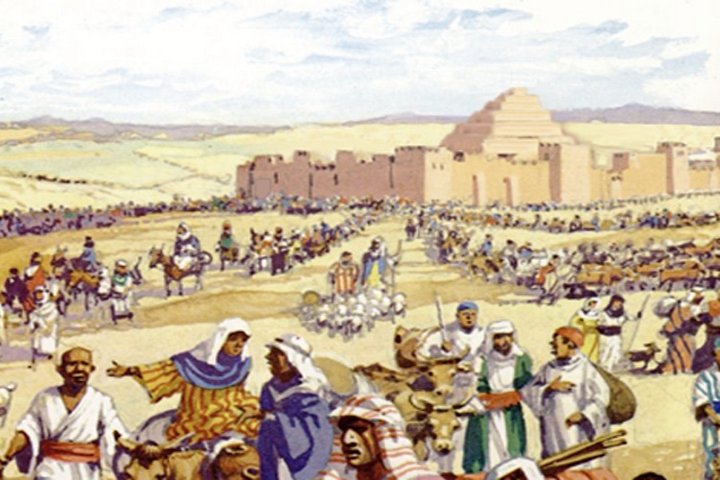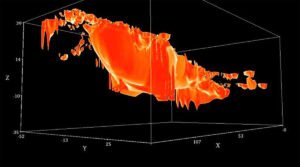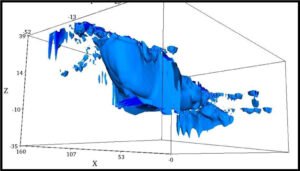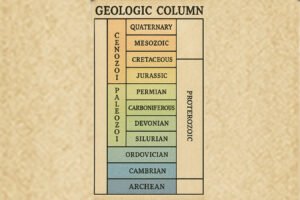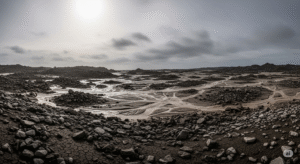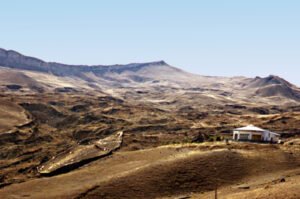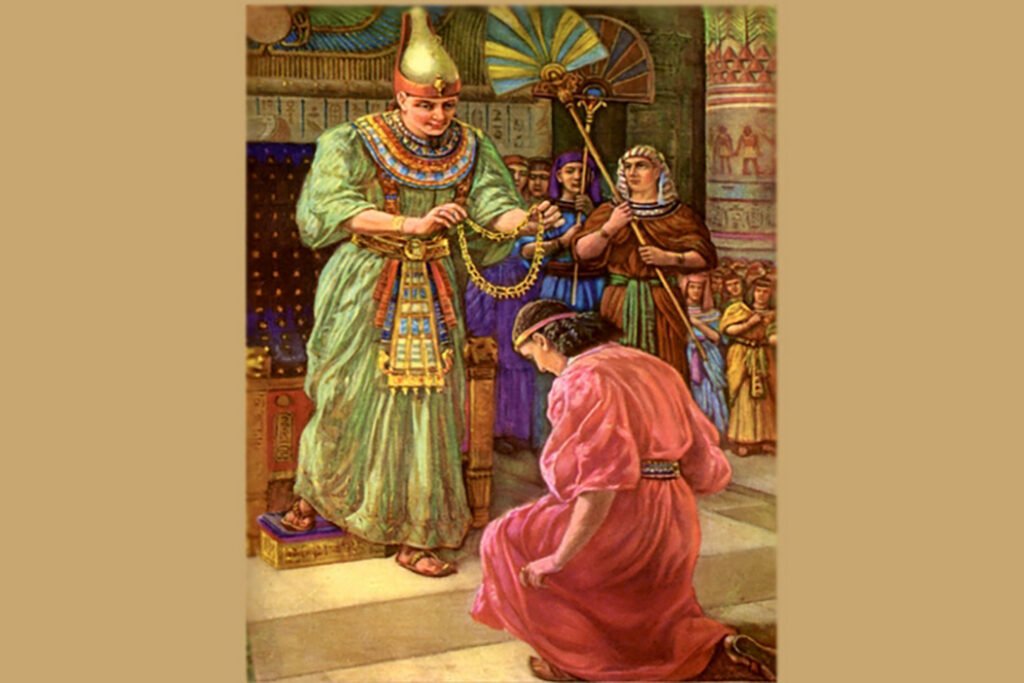Joseph- Preparing for the 7 Year Famine
It was Imhotep who is credited with having designed the first pyramid and began building with hewn stone instead of all mud brick. If we look at ancient Egyptian history, we can see evidence which shows that it was during the time of Djoser that Egypt became a truly great nation. It had gathered the wealth of all the surrounding nations by selling them grain during the famine.
Administrative Center for Selling Grain on a Massive Scale
During the 7 years of plenty, the people, under Joseph's wise guidance, began to organize a great administrative center which would handle the selling of the grain to all the surrounding nations, in addition to grain storage in all the large cities for the Egyptian people.
A large complex was built which contained the future burial site of the pharaoh and also included the center which contained huge grain bins. There was only one entrance into this center and there was an outside entrance into the system of storage bins. The Step Pyramid complex at Sakkara is the complex which we will now discuss.
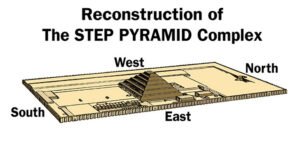
The Remains of the Complex
Surrounding the Step Pyramid, the first ever built, and its complex is a very beautiful and elaborate wall.
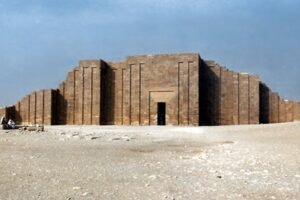
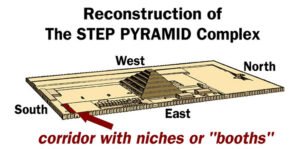
At the main entrance on the east wall at the southern end, one enters a long hall of 40 columns- 20 on each side. Each column is connected to the main wall by a perpendicular wall, forming small "rooms" between each column.
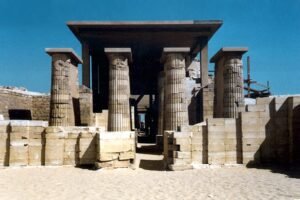
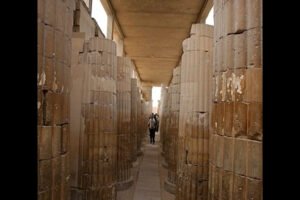
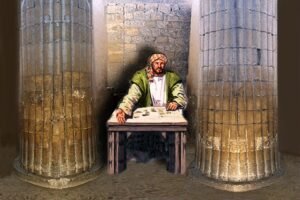
The Large Grain Bins
As you exit this colonnade and walk straight ahead, you come to a series of very large pits which extend deep into the earth. These are extremely large in size, and not feasible as a burial chamber as these open to the surface.
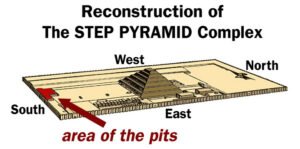
They are all centrally accessible by a connecting tunnel and extend to well above ground level.
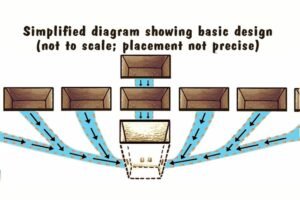
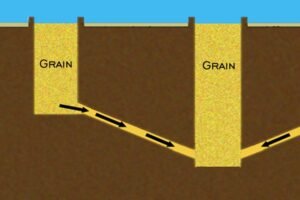
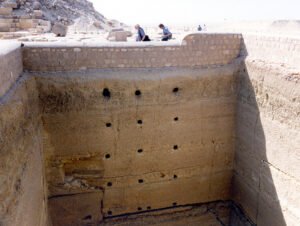
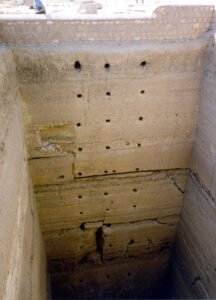
The Exit after Getting Grain

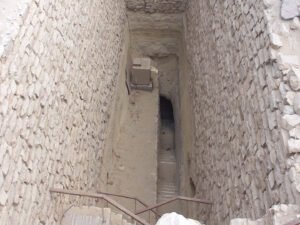
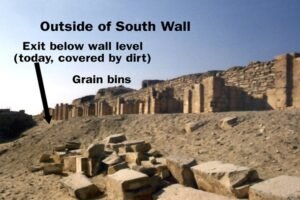
How We Know They are Grain Bins
These massive structures extend to well above ground level, which indicates that they were not hidden, as were tombs. Because the ancient Egyptians buried their dead with so much valuable material and provisions for their "afterlife", plundering of tombs was always their biggest fear. Therefore, we know that these massive pits had another purpose. Also, in all the other ancient cities, whenever large bins such as these were uncovered, they were recognized as "storage bins", but in Egypt, the scholars tend to term everything they find a "tomb".
These are clearly not tombs. And in the pharaoh's burial complex under the pyramid, we find matching bins for the king and his family's afterlife and in these bins were found grain and other food stuffs.
The Biblical Account of the Gathering and Storing of Grain
In the Biblical account, we learn that Joseph appointed men throughout the land of Egypt to oversee the gathering and storing of the grain in all the cities:
GEN 41:34 Let Pharaoh do this, and let him appoint officers over the land, and take up the fifth part of the land of Egypt in the seven plenteous years. 35 And let them gather all the food of those good years that come, and lay up corn under the hand of Pharaoh, and let them keep food in the cities.
Joseph had given this plan to the pharaoh prior to his appointment as vizier or prime minister and since it would be impossible for him to oversee the gathering and storing for the entire country, we know he implemented this plan of appointing people to help. We also know that when the famine began and the Egyptians began to cry for food, they were told to go to Joseph and do whatever he said, which indicates that he gave the orders for the distribution of the grain:
GEN 41:55 And when all the land of Egypt was famished, the people cried to Pharaoh for bread: and Pharaoh said unto all the Egyptians, Go unto Joseph; what he saith to you, do. 56 And the famine was over all the face of the earth: and Joseph opened all the storehouses, and sold unto the Egyptians; and the famine waxed sore in the land of Egypt.
But Joseph wasn't in every city, handling the distribution- He had people appointed in all the cities to carry out his commands.
Foreigners Also Came for Grain
But when the foreign peoples came to purchase grain, we learn that they went directly to Joseph:
GEN 42:6 And Joseph was the governor over the land, and he it was that sold to all the people of the land: and Joseph's brethren came, and bowed down themselves before him with their faces to the earth.
Joseph's brothers came directly to Joseph in person. We believe it is Sakkara to which they came, where the remains of this fantastic complex are preserved. And it was here that Djoser had 11 extremely large pits constructed which can only be grain storage bins.
Every city had stored grain from its region, but at this complex at Sakarra, we have these massive pits which would have stored an incredible amount of grain, more than a single city would have needed. Its location was perfect for people coming from Syria and Canaan.
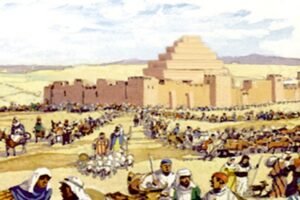
At the entrance to this complex, as we described earlier, there are 40 small cubicles, each just the right size to hold a single person who could administer the receipt of payment from people coming to purchase grain. There could have been several cashiers of each language group to handle the purchases of those who spoke the various languages. Of course, the Egyptologists think all these little cubicles were for statues, however, no pedestals were found in the remains, which is a very important point, because these statues were always erected on pedestals. Statues may vanish, but pedestals remain.
The design of the 11 pits is impressive. There are 11 of them, with only one containing a very elaborate stairway extending all the way to the bottom. All the pits are connected to each other by a subterranean tunnel. The pits were filled and the tops were sealed with wooden timbers and stone. And all of the grain could be accessed from one entrance and there is one entrance into the pits from outside the wall enclosure of the complex. Last of all, grain was found in the floor of these pits, which has been explained by Egyptologists as having been from foods buried with deceased who were buried there- however, no evidence of burials was ever found in these pits.
Does this fit the Biblical account? When Joseph's brothers came to him for grain, they talked to Joseph and paid for the grain. When they received the grain, it was already in sacks:
GEN 42:25 Then Joseph commanded to fill their sacks with corn, and to restore every man's money into his sack, and to give them provision for the way: and thus did he unto them. 26 And they laded their asses with the corn, and departed thence. 27 And as one of them opened his sack to give his ass provender in the inn, he espied his money; for, behold, it was in his sack's mouth.
The complex at Sakkara is unique. Nothing like it has ever been found. It was described by William Hayes as being a "veritable city in itself, planned and executed as a single unit and built of fine white limestone from the near-by Mukattam Hills." (The Scepter of Egypt, Vol. 1, p. 60.)
Egyptologists tend to term everything they find as a royal "tomb", which is what they have called this complex. But it in fact exhibits every feature indicative of being a center of great activity, a feature which again fits with the story of Joseph.
When Joseph's brothers came to get grain, they came face to face with Joseph who was overseeing the distribution. Where did they go to get the grain? They went to wherever the grain was stored, and the storage of such a massive amount of grain would have required a large storage area, such as the extremely large pits found in this complex.
It is also reasonable to expect to find the storage pits within an enclosure such as this complex, with an area for the payment of the grain. This was a "business" and would have required a center of administration. A great deal has been written about this complex, and most mention the uniqueness of it as something they cannot explain. In fact, when you ask the Egyptians what the huge pits were for, they admit that they just don't know.
Some ancient historians have written of the fact that the pyramids were once believed to be "Joseph's storage bins" for the grain. Perhaps this story has its roots in the fact Joseph designed the first pyramid in the same complex in which the grain was stored. But regardless of what the scholars want to believe about the Step Pyramid complex, the circumstantial evidence fits the story of Joseph perfectly. And, it is one of the best preserved site in Egypt.
The Search for Imhotep's Tomb
We know from the Bible that Joseph died in Egypt and was embalmed and placed in a coffin.
GEN 50:26 So Joseph died, being an hundred and ten years old: and they embalmed him, and he was put in a coffin in Egypt.
When the children of Israel left during the Exodus, his bones were taken with them:
EXO 13:19 And Moses took the bones of Joseph with him: for he had straitly sworn the children of Israel, saying, God will surely visit you; and ye shall carry up my bones away hence with you.
This leads us to think that Joseph would have had a royal tomb in Egypt, but that it was possibly taken over and used by someone else, we just don't really know. But one of the big mysteries for Egyptologists has been the tomb of Imhotep. They simply can't find it although they know it should be somewhere in Sakkara. So important is Imhotep to Egyptology, that in the Guidebook to Sakkara by Jill Kamil, "The Tomb of Imhotep" is listed as a subject heading, only to explain that it has not been found.
In our discussion of "Imhotep, the Physician", we mentioned that ancient Greek texts speak of a place near Memphis where people came to worship Imhotep and be healed. When excavators continued to search for Imhotep's tomb very near the Step Pyramid, they found an incredible labyrinth of underground tunnels, full of mummified ibis (birds) and bulls (in separate galleries). Inscriptions and coins found here show that people came here to be healed. They had found this "sanctuary to Imhotep" written of by the Greeks.
After the deification of Imhotep as "god of medicine" , he was given the title, "Chief One of the Ibis" and this was the connection of this labyrinth with Imhotep. These hundreds of thousands of ibis were mummified and brought here as tribute to Imhotep, filling these tunnels.
It was later discovered that these galleries connected to a pit that extends down to a funerary chamber which contains an empty coffin. They also discovered that this chamber belonged to a very large mastaba tomb which contained a second chamber full of broken stone vessels, and in the tomb's storerooms were jars whose clay-stoppers had the seal impression of Djoser. Here is absolute proof that this was the tomb of a very important person of Djoser's reign. No inscriptions were found on the walls and the sarcophagus was empty. But even more importantly, this mastaba is oriented to the north instead of the east, as the other pyramids and mastabas are. This was an important tomb of someone from Djoser's time- but the sarcophagus was empty.
There was even found an inscription by an anonymous Greek who came here, telling how he was cured and it was through a dream. Once again, the evidence speaks loudly of a wonderful story from the Bible- the story of Joseph.
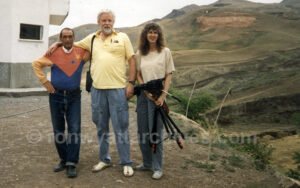
Welcome to the Ron Wyatt Archives. I'm Mary Nell (Ron's wife) and this site will attempt to fully document Ron Wyatt's work and discoveries. This website will be an ongoing project to document his work on all his various discoveries. Please check back often as new things will be added constantly.
| READ MORE |

